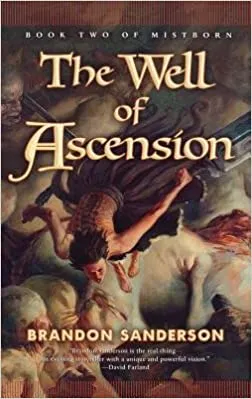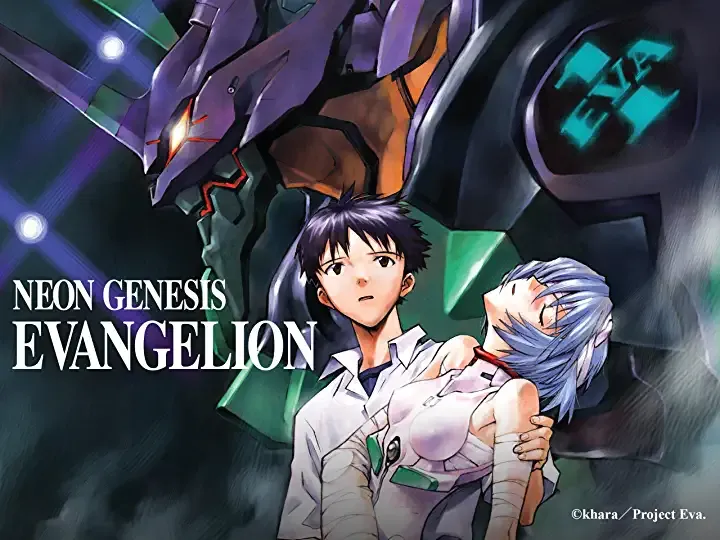I don’t often write about specific works of fiction. It’s hard to analyze a book or movie in a way that’s compelling to someone who hasn’t read or seen it, and the find-your-audience blogging experts would say that reducing your audience from “people who are interested in an amateur theologian and software developer’s wandering thoughts” to “people who are interested in those wandering thoughts and have any idea about what novel he’s referencing” is perhaps a mistake. But the nice thing about having a blog is that I’m free to occasionally wander wherever I like, and I’ve been reading some good books lately, so here we go.
Spoilers for the first two Mistborn books and “Neon Genesis Evanglion” follow.

I recently finished the second Mistborn book, The Well of Ascension, by Brandon Sanderson. Although he’s not extremely well known in broader culture, Sanderson is one of the biggest fantasy authors in the world and a prolific author, with over thirty novels to his name. The Mistborn series follows Vin, a young thief who grew up on the streets, as she falls in with a group of rebels, helps overthrow a tyrannical ruler, and discovers her own magical powers. As a fantasy series, it has many of the standard fantasy tropes: an immortal evil overlord, a carefully explained system of magical abilities, mysterious prophecies, centuries of backstory, and unearthly creatures.
It’s all fun and well-written, but the fantasy tropes aren’t what kept me thinking once the book was done - rather, it’s Vin’s relationship with a young nobleman, Elend, with whom she falls in love. Vin and Elend could hardly be more different. She grew up on the streets; he’s the son of the most powerful noble family in the empire. He’s an academic; she acts on instinct. Her life forced her to focus on practicality and survival; he’s an amateur philosopher and an idealist. Vin can use her magical abilities to become absolutely deadly in a fight; Elend can barely hold a sword. As the plot develops, they become responsible for a fledgling kingdom; Vin puts her talents to use at night, spying, keeping watch, and eliminating threats, while Elend spends his time politicking, drafting laws, and making speeches.
As their relationship progresses, neither of them think they’re right for the other. Elend contrasts his ivory tower philosophies with Vin’s resourcefulness and growing magical abilities and thinks she doesn’t need him; Vin thinks that Elend should have someone who can more properly fit into society and that she deserves to be alone in the shadows. The various mundane and supernatural threats that they face continually pressure them and force them to deal with them individually, and since neither can manage to talk openly about their concerns, the stresses and gaps and unknowns are filled in with insecurities and fears.
In spite of this, they come to love each other; toward the end of the book, they’re married in a brief, spur-of-the-moment ceremony, as Vin is getting stitched up after being wounded in her latest magic-empowered fight. When Elend asks a mutual friend, Sazed, for advice, Sazed tells him how to think about their differences:
At first glance, the key and the lock it fits may seem very different. Different in shape, different in function, different in design. The man who looks at them without knowledge of their true nature might think them opposites, for one is meant to open, and the other to keep closed. Yet, upon closer examination, he might see that without one, the other becomes useless. The wise man then sees that both lock and key were created for the same purpose. (p. 427)
Vin has serious trust issues. Her mentally ill mother killed her sister. Vin’s brother taught her life on the streets by telling her that everyone, even him, would eventually leave her - and he did. To survive, she fell in with various thieves’ gangs, where stronger members would frequently beat, assault, or steal from weaker members such as her. (The fact that Vin can have any kind of healthy emotional life is perhaps as fantastical as the book’s magic, especially when centuries of rule by an immortal evil overlord did not allow for the development of trauma-informed therapy.) Much of her relationship with Elend, then, involves learning to trust him, and much of the reason she falls in love with him is that he’s unwavering in his trust of her. It’s impossible for her to guarantee that he would never betray her - yet she finally concludes that “she’d rather trust him and be wrong than deal with the worry of mistrust.”
While Vin’s and Elend’s relationship progresses (and armies invade and conspiracies transpire and omens portend and so forth - this is a fantasy novel, after all), their friend Sazed goes through struggles of his own. He’s a Keeper - a member of an order of scholars who’ve dedicated themselves to preserving the world’s lore during the dark age of the evil overlord’s reign. Sazed’s specialty is religions; he’s memorized three hundred of them, because he believes that these beliefs and stories have value. When questioned as to how he can promote these religions, despite their mutual contradictions, he explains that they represent hope - hope that there is something greater than humanity, hope that better times will come in the future. However, despite his scholarship and wisdom, his quiet strength, and the support he offers his friends, events in the book leave him shattered; although he believed in hope as an abstract concept, there was nothing concrete in any of the three hundred religions that could give him comfort.
Love, marriage, trust, hope - none of these are new topics, and all have been dealt with by numerous philosophers, theologians, ethicists, and self-help books. So, from one perspective, we don’t really need a popular fantasy novel presenting its take on things. But God has given us both emotion and reason. (As Blaise Pascal said, “The heart has its reasons which reason knows nothing of.”) And art and stories can touch emotions in a way that propositional truths may not; art is art because it shows something true about life, and sometimes showing is worth more than telling. (This may be part of the reason that God himself so often communicates through stories and parables.)
During The Well of Ascension, Vin has the opportunity to pursue a relationship with someone more like her, another magic-empowered outsider, but she eventually decides to place her trust in her key-and-lock relationship with Elend. And it is a relationship of trust - she has to accept that, however much the street-scarred survivor in her wants to ensure that she will never be hurt again, she cannot guarantee that, and she loves him anyway. The trust that Vin and Elend place in each other allows them to find strength when the abstract belief of Sazed fails.
This all has me thinking about our relationship with God. Christianity is, at its heart, a relationship with a Person, not a system of belief in abstract concepts. Christians often talk about the God-shaped hole in each of us. Blaise Pascal, again:
What else does this craving, and this helplessness, proclaim but that there was once in man a true happiness, of which all that now remains is the empty print and trace? This he tries in vain to fill with everything around him, seeking in things that are not there the help he cannot find in those that are, though none can help, since this infinite abyss can be filled only with an infinite and immutable object; in other words by God himself. (Pensées VII (425))
We may try to fill this hole with things on earth - for example, with relationships with those just like us - rather than looking toward the lock-and-key relationship with the Creator who seeks to relate to us. (This of course stretches the metaphor - a key and lock are created for each other, but God in no way depends upon us. I appreciate the poetry of the image regardless.)
It also illustrates something of the nature of faith. We talk at length about the importance of faith, what it means to have faith that’s accompanied by works, the relationship between faith and doubt, why God allows for faith rather than arranging for certainty, and so on. All of these are good and valuable discussions, but at the simplest level, faith is trust in a Person. Faith and doubt coexist because sin-scarred survivors such as ourselves can never guarantee that another person won’t hurt us - many of our doubts are fundamentally relational rather than intellectual. (If God is real and loves me, why doesn’t he act as I expect him to? Why am I still hurting? Why is the world still hurting?) Faith comes when, in spite of this, we choose to trust in One who is unwavering in his love toward us.

Thinking about Pascal’s “empty print and trace,” the God-shaped hole that we attempt to fill with shallow relationships with each other, reminds me of “Neon Genesis Evangelion,” a 1990s Japanese anime. One of the most popular anime ever, it tells the story of Shinji Ikari, an asocial Japanese 14-year-old, who’s drafted along with other teenagers to pilot giant robots in defense of Earth against invading alien monstrosities, dubbed “angels.” He does so as a member of Nerv, a UN-backed paramilitary group led by Shinji’s absentee father, Gendo. “Neon Genesis Evangelion” is a short series (26 episodes, 24 minutes each - anime is more likely than American television to tell a story and wrap up) but dense, with psychological drama, conspiracies within conspiracies, Jewish Kabbalah references, and critical elements of backstory and motivation that are merely hinted at. For example, Nerv’s motto (which is never directly referenced in the show but is visible onscreen as part of their logo) is “God’s in his heaven, all’s right with the world.” This quote from the 19th century poem “Pippa’s Song” sounds inspiring, but as the series unfolds, it becomes clear that Nerv considers God to have abandoned humanity, just as Nerv’s leader Gendo has abandoned his son, Shinji, leaving Nerv to play God on its own.
Early in the series, Shinji is introduced to the concept of “the hedgehog’s dilemma” - porcupines want to be close to each other, but when they try to do so, they only hurt each other. This becomes a recurring metaphor - humans seek to fill their emptiness with each other, desperately seeking the approval of others, yet they repeatedly hurt each other in the process.
Despite the show’s at times bizarre religious references, this theme ends up sounding quite Christian. Without our Father (in Christian terms, in rebellion against God), yet created for relationship and needing love, we try to fill our emptiness with each other. In the science-fiction anime world of “Evangelion,” this takes the form of a conspiratorial project to psychically meld humanity’s minds together; in real life, it can take the form of the distractions of entertainment, pleasure, work, or it can take the form of seeking relationships with others just like us, longing for someone we can trust and yet hurting each other like hedgehogs, instead of trusting in our relationship with our Father and accepting his love.